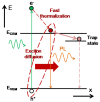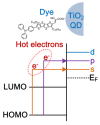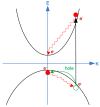The Way to Pursue Truly High-Performance Perovskite Solar Cells
- PMID: 31492035
- PMCID: PMC6781066
- DOI: 10.3390/nano9091269
The Way to Pursue Truly High-Performance Perovskite Solar Cells
Abstract
The power conversion efficiency (PCE) of single-junction solar cells was theoretically predicted to be limited by the Shockley-Queisser limit due to the intrinsic potential loss of the photo-excited electrons in the light absorbing materials. Up to now, the optimized GaAs solar cell has the highest PCE of 29.1%, which is close to the theoretical limit of ~33%. To pursue the perfect photovoltaic performance, it is necessary to extend the lifetimes of the photo-excited carriers (hot electrons and hot holes) and to collect the hot carriers without potential loss. Thanks to the long-lived hot carriers in perovskite crystal materials, it is possible to completely convert the photon energy to electrical power when the hot electrons and hot holes can freely transport in the quantized energy levels of the electron transport layer and hole transport layer, respectively. In order to achieve the ideal PCE, the interactions between photo-excited carriers and phonons in perovskite solar cells has to be completely understood.
Keywords: hot-carrier characteristics; perovskite solar cells; quantized electron transport layer; quantized hole transport layer.
Conflict of interest statement
The authors declare no conflict of interest.
Figures





Similar articles
-
Persistent Energetic Electrons in Methylammonium Lead Iodide Perovskite Thin Films.J Am Chem Soc. 2016 Dec 7;138(48):15717-15726. doi: 10.1021/jacs.6b08880. Epub 2016 Nov 29. J Am Chem Soc. 2016. PMID: 27934024
-
High-Efficiency Perovskite Solar Cells.Chem Rev. 2020 Aug 12;120(15):7867-7918. doi: 10.1021/acs.chemrev.0c00107. Epub 2020 Jul 28. Chem Rev. 2020. PMID: 32786671
-
Improving the photovoltaic performance of perovskite solar cells with acetate.Sci Rep. 2016 Dec 9;6:38670. doi: 10.1038/srep38670. Sci Rep. 2016. PMID: 27934924 Free PMC article.
-
Slow Hot-Carrier Cooling in Halide Perovskites: Prospects for Hot-Carrier Solar Cells.Adv Mater. 2019 Nov;31(47):e1802486. doi: 10.1002/adma.201802486. Epub 2019 Jan 2. Adv Mater. 2019. PMID: 30600555 Review.
-
Molecular materials as interfacial layers and additives in perovskite solar cells.Chem Soc Rev. 2020 Jul 6;49(13):4496-4526. doi: 10.1039/c9cs00733d. Chem Soc Rev. 2020. PMID: 32495754 Review.
Cited by
-
Advances in Emerging Solar Cells.Nanomaterials (Basel). 2020 Mar 17;10(3):534. doi: 10.3390/nano10030534. Nanomaterials (Basel). 2020. PMID: 32192074 Free PMC article.
References
-
- Katayama K., Inagaki Y., Sawada T. Ultrafast two-step thermalization processes of photoexcited electrons at a gold surface: Application of a wavelength-selective transient reflecting grating method. Phys. Rev. B. 2000;61:7332–7335. doi: 10.1103/PhysRevB.61.7332. - DOI
-
- Xie Y., Li Y., Xiao L., Qiao Q., Dhakal R., Zhang Z., Gong Q., Galipeau D., Yan X. Femtosecond Time-Resolved Fluorescence Study of P3HT/PCBM Blend Films. J. Phys. Chem. C. 2010;114:14590–14600. doi: 10.1021/jp912288p. - DOI
-
- Kirton P., Keeling J. Thermalization and breakdown of thermalization in photon condensates. Phys. Rev. A. 2015;91:033826. doi: 10.1103/PhysRevA.91.033826. - DOI
-
- Shockley W., Queisser H.J. Detailed Balance Limit of Efficiency of p-n Junction Solar Cells. J. Appl. Phys. 1961;32:510–519. doi: 10.1063/1.1736034. - DOI
Publication types
Grants and funding
LinkOut - more resources
Full Text Sources

